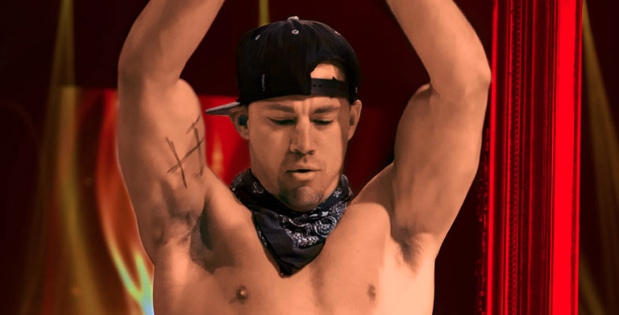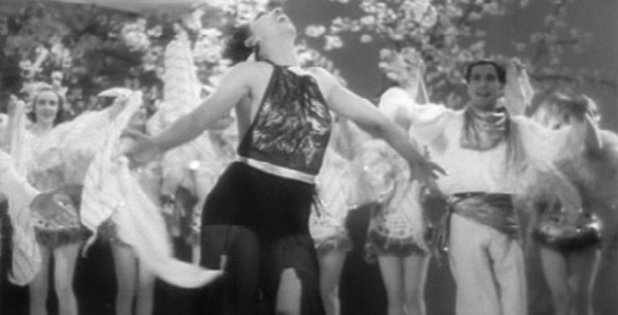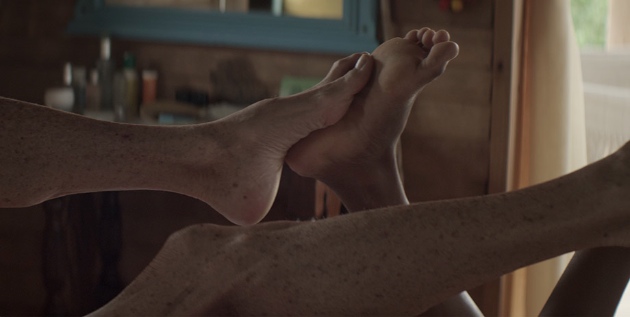
Dance might be where grace gets some of its most limiting connotations. You know, that floating-two-inches-above-the-ground, not-a-hair-out-of-place conception of “poise.” Fortunately, these clichés don’t jive with a lot of the dancing we see on screen. From Josephine Baker to Magic Mike XXL, both actors and the characters they represent have often directed their (usually very impressive) moves towards more disruptive, political or contemplative ends. Then again, sometimes they haven’t. In our latest roundtable, writers Zeba Blay and Sarah Nicole Prickett join cléo managing editor Julia Cooper to talk fetishization, dancing alone, and Channing Tatum. – the cléo editors
ZEBA BLAY: I’ve always been thoroughly bored by Fred Astaire and Ginger Rogers. Of course, I get it. I get the ease, the glamour, the elegance that they both embodied. I certainly count Astaire as one of the great onscreen dancers of all time. But I’m bored. If grace is about being immaculate, precise, deceptively uncomplicated, then that’s not the grace I’m drawn to. I’m interested in the grace in wildness—Josephine Baker is a brilliant example of this. I’ll never forget watching her dance in Princess Tam-Tam (1935), where she plays this “exotic” African “wild woman” from the bush who is brought to Paris and becomes the toast of the town when she’s passed off as foreign royalty.
In the scene, she’s at this swanky nightclub watching a show, dressed head-to-toe in expensive silks and jewels, playing the part of the refined socialite. But then the band starts playing. The trumpets and the drums remind her of home and she loses her shit. She can’t resist! She rips off the jewels, throws off her shoes, rushes to the stage and starts writhing to the music. Swinging her hips and arms, kicking her feet, smiling manically. These French Afrophiles absolutely loved the novelty of seeing this wild, untamed, almost primal, wholly “ungraceful” being. But I think so often, and especially in this scene, Baker’s control, her technique, is totally taken for granted. It’s supposed to be titillating to these white aristocrats but from my point of view it’s wholly unerotic. I’m watching this woman, this black American woman, using her body to symbolize pure freedom, even as she’s being fetishized and exotified by literally everyone around her. That’s grace.

SARAH NICOLE PRICKETT: Last week I watched Black Swan (2010) again. I listened for the word grace, but because ballet is already the definition of grace—of traditional grace, of “being immaculate, precise, deceptively uncomplicated,” as Zeba says—the word only appears once. Nina (Natalie Portman) walks into the dressing room and another dancer snidely says to her: “Oh, look who’s gracing us with her presence.” The expression is common because it’s true. Grace is something bestowed. In Christianity, it’s bestowed from above. Growing up I was taught that grace was something you could neither earn nor deserve, which makes it a peculiar requirement for dance—dance, of course, being so tightly laced with competition. You can be the fastest, the highest, the thinnest, the most in control. But anyone trying to be the most graceful has already failed.
Zeba’s description of Josephine Baker fits almost too well with the job description of the Black Swan in the ballet Swan Lake: a wild, gleaming, menacingly free foil to the captive princess. I’m not here to racialize Swan Lake. I also don’t have to—just read last year’s coverage of Misty Copeland, the first African-American Odette/Odile in American Ballet Theater history, and we all know how “unlikely” she was set up to be. Myth would have it that a light woman can access her dark side, while a dark woman can’t become light. So yes, of course it’s a problem when grace is associated with God and with goodness and with a kind of inherent ascension. I’d rather think of grace as a break from the rules. Incidentally so would God, the Bible being full of statements like “you are not under law, but under grace.”
In A Woman Under the Influence (1974), Mabel (Gena Rowlands) dances the dance of the dying white swan in her backyard, Tchaikovsky on cassette, her children and her neighbour’s children bumbling around her, balloons in the air. It’s bathetic because she looks happy and no one else does (the kids are reluctant, the neighbour concerned). It’s graceful in that she looks exhausted but she’s light on her feet. In An Unmarried Woman (1979), Erica (Jill Clayburgh) dances madly in her sensible white underwear to what I think is the very same music when it comes on the radio (it’s not on Netflix anymore, so I’m going by memory). Her husband has just left for work, she’s not yet dressed, it’s a little winged flight from the day. Grace is the fact that she takes it. She doesn’t worry for a minute about what she’s earned, and her movements don’t show any strain.
JULIA COOPER: You’ve both brought up this double bind in grace—it can appear where it’s not meant to, and the more you tighten your grip around it the quicker it dissolves. Baker graces us with her movement and, if only for a contemporary audience, exceeds the fetish—Portman as the Black Swan can internalize the fetish and die in bliss. Grace is beginning to sound more and more like desire—it’s beyond our control, except when it’s not; it’s elusive, but somehow everywhere; it feeds itself.
Grace and longing are twinned in the first dance movie I ever saw: Dirty Dancing (1987). What struck me as a young girl—trained in ballet and its boring gender codes—was that it was the man who possessed the grace. Patrick Swayze in his tight black pants and ribbed tank top was a leaner version of the hard body you could easily recognize in action movies of the 1980s, but his working-class, chiseled arms were meant for the mambo. Dancing is like fucking, sure, but there’s a cadence to each that can’t be taught—Jennifer Grey as Baby only becomes graceful when she learns the contours of her want. She finds her rhythm as a dancer when she’s able to feel her own desire, to tongue her grace.
ZEBA BLAY: I really like this idea of dance being a tool for pushing up against or complicating gender roles. In partner dancing, there’s always the “lead” and the “follow” and the lead is always male. But one of the things I’ve always been weirdly drawn to in this sub-genre of Dirty Dancing-esque films, romance films like Save the Last Dance (2001) or Strictly Ballroom (1992) or (dare I say it) Silver Linings Playbook (2012), is that the main conflict is almost always the female partner’s unwillingness or inability to just blithely do what she’s told. That final, perfect routine is possible not only when she finds herself as a dancer by discovering or rediscovering her body, but when the “lead” recognizes, accepts, and respects the capabilities of her body as well.
Since we’re talking about the masculine and feminine in dance, what do you think of Magic Mike (2012) and Magic Mike XXL (2015)? Much has been said about the feminist qualities of these movies, specifically XXL; how they’re a kind of celebration of women through the unapologetic objectification of men. Honestly, though, the first thing that really struck me about these movies was how good of a dancer Channing Tatum is. Sure, he’s hunky (I guess), but the film’s really highlight the fact that strip dancing is an art form.
The second thing that struck me, though, was how a film like Magic Mike would be received if it were about female strippers? The novelty of Magic Mike completely hinges on gender, of course, it’s empowering because for once it’s not women being ogled at and objectified. But while we’re ogling we’re also respecting the technique and the talent. For female strippers, the technique and talent and sheer athleticism of pole dancing or twerking is incidental, it’s secondary, if it’s even acknowledged at all. Showgirls (1995) tried, and failed, to elevate it to an art form, but I’d love to see more onscreen depictions of burlesque and exotic dancing that weren’t mired by respectability.
JULIA COOPER: I agree with you Zeba that an all-female cast would look very different in its critical and popular reception—I want to see that movie—but I wonder if Magic Mike XXL isn’t as free from respectability politics as it seems? For instance, what would an all-black cast look like? It seems crucial to the film’s popularity that the white Tatum is our leading man—with his sideways ball cap he’s like a lit Denis the Menace all gee shucks and yes ma’am. We learn from Jada Pinkett Smith’s character that Magic Mike used to go by the stage name “White Chocolate”; is the gyrating white male body a way of making “respectable” or “accessible” or, pick your scare quotes, a supposedly comforting white washing of the black sexuality associated with hip hop?
SARAH NICOLE PRICKETT: An all-black cast in a male stripper movie would look like this year’s Chocolate City, which I think went straight to VOD; I found it flipping through a list of on-demand movies in the Roanoke DoubleTree last month. The director, Jean-Claude La Marre, made it as an homage and corrective to, or institutional critique of, the first Magic Mike, with which he said the only problem was the lack of color. In an interview, Channing Tatum said, “I think [Chocolate City will be] awesome. The name is so crazy, I’m like what!” Because the name Magic Mike is sane? Instead of the role offered to him in Chocolate City, which had a budget of $20,000, Tatum reprised Mike in the aforementioned and more interesting sequel, which had a budget of $15 million and made tenfold more at the box office. Here we find out that his first mentor was Jada Pinkett Smith, boss of a male strip club for black women, and his first stripper name was…White Chocolate.
After seeing XXL, the scholar Tressie McMillan Cotton wrote that, “Unlike the many artists that perform black or gay or Harajuku without giving credit where it’s due, Tatum wants to be clear about where Mike got his magic.” It’s also clear that movies get their (box office) magic from alchemizing difference into something with “universal” appeal, and not, in this case, from making a gonzo corrective to hegemony that is of course also homogenous.

JULIA COOPER: Magic Mike XXL does elevate stripping—or, “male entertainment” as the men insist it be called—to an art form. It also elevates it to an act of altruism. As one of the strippers explains, women come to see them perform because they are sick and tired of being ignored at home—male entertainment makes a woman feel whole again. This makes men women’s primary problem but also their solution, and stripping is somehow privileged as an ethical act. Male entertainment becomes pleasurable charity work that reduces the gender gap by stuffing it with one dollar bills.
When Tatum reprises his dance to Ginuwine’s “Pony” in XXL, he does it in his woodshop without an audience. His athleticism is a thing of grace and beauty and this scene of him hovering, thrusting, and glistening does all kinds of things to and for me. What I love most is that he does it alone. It got me thinking of other movies where women dance on their own, for no one else’s eyes. The opening scene of Adventures in Babysitting (1987) comes to mind, when we see Elisabeth Shue singing the Crystals’ “And Then He Kissed Me.” How do we move our bodies when we think no one is looking?
SARAH NICOLE PRICKETT: In the new Starz show Flesh and Bone (a ballet-of-hard-knocks psychodrama with multifarious and often awful plots that I watched in one night and half a day), the lead ingénue, Claire, follows her new friend fatale into life after hours as a stripper. Claire has the approximate poise and IQ of a velveteen rabbit (that’s her favourite book, The Velveteen Rabbit), and the men on show, who didn’t get enough stuffed animals as children, all love it. When she first takes to the pole, she strips as if on benzos and Doves, slowly but slooooowly peeling off a fuzzy pale cardigan and jeans to reveal what seems to be baby’s first Journelle set. She eschews anything we’d call a “move” in favour of barely-there movements that range from circling the pole like it’s Romeo and she’s Juliet in Romeo + Juliet to lying on the floor like she’s in the Natalie Imbruglia song “Torn.” I was so mad, but also mesmerized, mostly because she was “dancing” as if no one, including her, was watching. The logical end to a popular cliché of male fantasy: a stripper so nice even she doesn’t know what she’s doing here.
For while this scene was stupid, it was graceful. When talking about Swan Lake, I suggested that the way we (or we women) dance alone and in grace is with abandon. It can also be with an amazement that when no one is looking we still have bodies. Stupefaction is not to my taste, but I recognize it from a much younger and wannabe ballerina version of me I’d rather forget.
I tend to like even the trashiest visualizations of female strippers over the macho feminism of Magic Mike, which, in the often beautiful but hardly beatific act—and job—of stripping, reinterprets grace as something gifted not by God (or Whatever) to the dancer, but by the dancer to the audience, as Julia said. Not that I’ve never referred to a film I paid to see as a gift. More that as far as I can tell from acquaintance, observation, and not being clueless, most strippers of all genders would prefer to operate well outside the realm of favour.
ZEBA BLAY: Well put, Sarah. What’s so fascinating about this concept of “dancing alone” or “dancing like no one is watching” is that when it comes to dance in film, someone is always watching. Dance, in real life, is all about the performance in that moment—it’s supposed to be ephemeral. But then I think of something like Maya Deren’s three-minute short A Study In Choreography for the Camera (1945). This silent, black-and-white clip of the great African American choreographer Talley Beatty beautifully contorting his body into a series of elegant, perfect poses. But what’s most striking isn’t his dancing, but the dance between him and the camera, the way Deren’s frantic editing drives and complicates his movements.
Beatty raises his foot in a wooded forest, and when he places it down again he’s now in a dimly lit living-room, then in a large museum hall. There’s this final leap at the end, segmented into something like six or seven cuts as his silhouette moves across the frame. These are the kind of transitions that we’ll see in classic dance-musicals like An American Paris (1951) and Singin’ In The Rain (1952). They emphasize the storytelling that’s inherent in dance, and they’re the kind of moments that I think speak to the overall beauty in the marriage of cinema and dance. So much of what we’ve discussed just cements what excites me and what will always excite me about dance on film. Dance may be ephemeral, but with cinema, it’s infinite.
Zeba Blay is a Ghanaian critic based in New York City. She is the Culture Writer at The Huffington Post, and host of the podcast Two Brown Girls. She previously wrote about Shonda Rhimes for cléo’s “boob tube” issue.
Sarah Nicole Prickett is writer in New York and the founding editor of Adult.
Julia Cooper is the managing editor of cléo.




